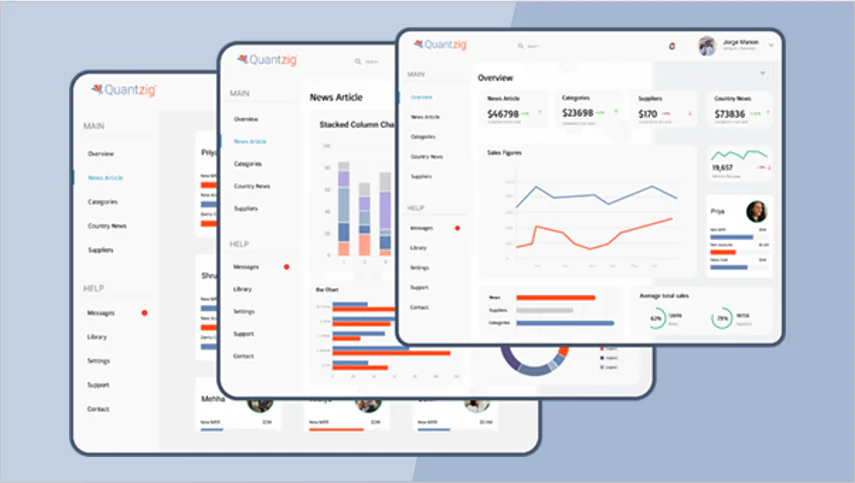Machine learning models have transformed industries by enabling data-driven decision-making, automation, and predictive analytics. These models allow systems to learn patterns, make predictions, and improve over time without explicit programming. They form the backbone of technologies such as fraud detection, recommendation systems, and self-driving cars, showcasing their widespread impact across sectors.
Understanding the different types of machine learning models, their advantages, and potential challenges is crucial for businesses aiming to leverage AI-powered analytics. In this comprehensive guide, we will explore machine learning models in detail, covering their importance, advantages, disadvantages, strategies for implementation, real-world applications, and future developments.
Discover how machine learning models can optimize your business operations and decision-making processes.
Request a DemoTable of Contents
What Are Machine Learning Models?
Machine learning models are algorithms that analyze data, learn from patterns, and make decisions or predictions without being explicitly programmed. These models use statistical techniques to enable computers to improve performance on a specific task as they process more data.
Key Features of Machine Learning Models
- Data-Driven Learning – Improves efficiency by learning from historical and real-time data.
- Automation – Reduces manual intervention by making independent data-driven decisions.
- Scalability – Handles vast amounts of structured and unstructured data seamlessly.
- Versatility – Used across industries, including healthcare, finance, and retail.
- Predictive Analytics – Forecasts trends and future outcomes based on past data.
- Data-driven Learning – Machine learning models enhance efficiency by continuously learning from historical and real-time data, enabling systems to adapt and improve over time without human input, leading to better decision-making and performance optimization.
- Automation – By leveraging data-driven insights, machine learning models automate decision-making processes, reducing the need for manual intervention. This allows organizations to streamline operations and improve productivity with minimal human oversight.
- Scalability – Machine learning models can efficiently handle vast amounts of both structured and unstructured data. Their ability to scale ensures they remain effective as data volumes grow, making them invaluable for businesses experiencing data growth or variability.
- Versatility – Machine learning is widely applicable across industries, including healthcare, finance, and retail. Its ability to adapt to different data types and problem sets allows businesses to harness its power for diverse applications, from customer service to fraud detection.
- Predictive Analytics – Leveraging historical data, machine learning models provide actionable insights through predictive analytics, enabling businesses to forecast future trends and outcomes. This helps organizations make proactive decisions, mitigating risks and maximizing opportunities.
Importance of Machine Learning Models
Machine learning models play a vital role in driving innovation, optimizing business processes, and improving customer experiences. They allow organizations to make informed decisions, enhance operational efficiency, and gain competitive advantages by analyzing vast datasets at unprecedented speeds.
Advantages of Machine Learning Models
- Improved Accuracy – ML models analyze large volumes of data, identifying patterns humans might miss, leading to more precise predictions.
- Real-Time Decision Making – Businesses can automate responses to critical scenarios, such as fraud detection in banking.
- Cost and Resource Efficiency – Automates repetitive tasks, reducing operational costs and increasing efficiency.
- Enhanced Personalization – Used in recommendation engines, tailoring content and experiences to individual users.
- Continuous Learning – Models refine themselves over time, ensuring improved performance with more data.
Disadvantages of Machine Learning Models
- High Data Dependency – Poor data quality can lead to inaccurate results and unreliable predictions.
- Complexity in Implementation – Developing ML models requires expertise in AI, statistics, and data science.
- Lack of Transparency – Some models, such as deep learning, act as “black boxes,” making it hard to interpret decisions.
- Overfitting Issues – ML models can become too specialized in training data, reducing generalization to new datasets.
- Ethical Concerns – Bias in training data can lead to unfair or discriminatory decision-making outcomes.
Strategies for Implementing Machine Learning Models
- Data Quality Assurance – Prioritize the collection of high-quality, representative, and unbiased data to train models. Regularly audit the data for completeness and consistency, and use techniques like data augmentation to enhance diversity and reduce bias, ensuring the model’s performance is not skewed by imperfect data.
- Algorithm Selection – Carefully evaluate and select machine learning algorithms based on a deep understanding of the business goals, the specific nature of the data (e.g., structured vs. unstructured), and performance benchmarks. Additionally, consider hybrid approaches or ensemble methods to improve robustness and model accuracy in complex scenarios.
- Cross-Validation – Implement advanced cross-validation techniques, such as stratified k-fold or leave-one-out cross-validation, to enhance the model’s ability to generalize. This process reduces overfitting risks by testing the model on different subsets of the data, ensuring it performs reliably on unseen data.
- Model Monitoring & Updating – Continuously monitor the model’s performance through real-time analytics and performance metrics to track any decline in accuracy or relevance. Regularly retrain the model with fresh data to ensure its predictions remain aligned with evolving trends and business requirements, while also incorporating feedback loops for optimization.
- Ethical Considerations – Integrate ethical frameworks into the machine learning development lifecycle, ensuring transparency, fairness, and accountability at every stage. Perform regular audits for bias detection and engage with diverse stakeholders to ensure models are inclusive and comply with regulations, promoting trust in AI systems.
Applications of Machine Learning Models
Machine learning has diverse applications across industries, revolutionizing processes and driving innovation. In healthcare, it aids in diagnostics by analyzing medical images, predicting patient outcomes, and personalizing treatment plans. Finance leverages machine learning for fraud detection, risk management, and algorithmic trading, enhancing decision-making and operational efficiency. In retail, it optimizes inventory management, customer experience, and personalized recommendations, boosting sales and customer satisfaction.
Additionally, machine learning plays a key role in transportation, powering autonomous vehicles and improving logistics and route optimization. Marketing benefits from predictive analytics to forecast customer behavior and tailor marketing campaigns for higher engagement. Across these sectors, machine learning is transforming operations, improving accuracy, and unlocking new opportunities for innovation and growth.
Explore how Quantzig’s AI-driven analytics solutions can drive business growth through machine learning models.
Request a PilotWhat the Future Holds for Machine Learning Models
Emerging Trends & Innovations
Improving transparency and interpretability of complex ML models.
Streamlining model selection, hyperparameter tuning, and deployment.
Enabling privacy-focused training across decentralized devices without sharing raw data.
Leveraging quantum computing for enhanced AI capabilities and problem-solving.
Ensuring fairness, accountability, and trustworthiness in AI applications.
As machine learning evolves, businesses must stay ahead by integrating advanced models that enhance decision-making, efficiency, and customer engagement.
Conclusion
Machine learning models have revolutionized industries, from healthcare and finance to retail and marketing. Their ability to analyze large datasets, detect patterns, and make real-time decisions makes them invaluable for businesses aiming to stay competitive in the digital age.
While ML models offer significant advantages, organizations must address challenges such as data bias, model transparency, and ethical considerations. By adopting best practices in model development, deployment, and monitoring, businesses can unlock the full potential of AI-powered decision-making.
Discover how Quantzig’s expertise in machine learning can help drive business transformation and innovation.
Start your Trial Today



